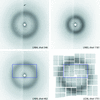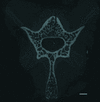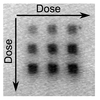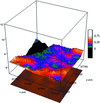issue contents
May 2018 issue

Cover illustration: Volume rendering representation of a silicate melt (rhyolite) distribution in a solid silicate matrix (olivine) acquired in 10 s at high pressure and temperature (3 GPa, 1600 K) (see Boulard, King, Guignot, Deslandes, Le Godec, Perrillat, Clark, Morard and Itié, pages 818-825). The sample was scanned in situ by the use of a pink beam projected through a standard Paris-Edinburgh press in order to demonstrate the possibility to perform high-speed synchrotron X-ray tomography at high pressure and temperature.
facility information
feature articles
Open  access
access
 access
accessThe plans for an upgrade of the Swiss Light Source are presented, covering the storage ring lattice concept, the accelerator component designs, the insertion device developments and the science potential of the upgraded facility.
research papers
Open  access
access
 access
accessDetails and performances of a transmissive pulse intensity diagnostic for the LCLS `nanosecond double-bunch' mode are presented.
Jitter of XFEL signals due to fluctuations in shot-to-shot time delays and intensities are explored in the frame of a statistical theory of X-ray diffraction from liquids.
Open  access
access
 access
accessDeep learning provides one possible avenue to reduce the data stream generated by serial macromolecular X-ray crystallography. Convolutional neural networks can be trained to recognize the presence or absence of Bragg spots, forming a criterion to veto events prior to downstream data processing.
A hybrid model describing the X-ray absorption by a gas attenuator using argon and the subsequently generated plasma is presented. The model is able to reproduce the spatial distribution of the excited stated measured experimentally, as well as the decrease of the gas density along the attenuator axis.
Open  access
access
 access
accessThe design, the magnetic optimisation and the characterisation of the Aramis undulators are presented. The SUBLIME model integrates all the information gained during the series production and the test campaign to operate the Aramis undulator beamline, including phase matching and orbit correction.
A parallel X-ray reflectivity technique with time resolution of 100 ms, enabled by the application of a polycapillary X-ray optic, is described. This method is applied to the observation of epitaxial thin-film growth.
The fractional Fourier transform for numerical wavefront propagation has been adapted for use with X-rays, which alleviates the strict sampling requirements encountered in typical Fourier optics. This approach also allows wavefront propagation through multiple lenses in a single transform, and that property is leveraged in two numerical examples for compound refractive lenses.
Wet chemical development of exposed resist, and beam calorimetry, are applied to determine the surface condition of grazing-incidence mirrors exposed to synchrotron radiation. Using this technique, the mirror reflectivity can be assessed without directly probing the surface and without the need for spectral analysis.
Open  access
access
 access
accessAn original scheme has been formulated for a broadband X-ray spectrometer with excellent resolving power throughout the whole spectral range, while the sagittal spot size is well confined to enhance the detection efficiency. The intrinsic optical nature and the most fundamental problems in the system have been comprehensively investigated.
Simulated X-ray diffraction patterns of shock-compressed single-crystal tantalum for polychromatic synchrotron undulator sources at different shock velocities and detection geometries are presented, along with their interpretation.
Open  access
access
 access
accessThe observation of the effects of radiation pressure of a Gaussian beam by tracking the rotation motion of single-crystal nanoparticles is presented.
Both beam-induced oxidation and reduction occur during As K-edge XAS measurements. The coexisting oxidizing and reducing agents and the solid-phase As speciation were found to be important factors in determining the vulnerability of As to beam-induced redox transformation.
Optical constants of MgO thin film in the energy range 40–300 eV are reported and the influence of the core-hole effect on the optical constants near the Mg L-edge region are discussed.
Configuration interaction cluster calculations are a powerful tool for understanding the multiplet structures of the Ti L2,3-edges absorption spectrum of SrTiO3 which yields different energy parameters representing the ground state properties. Simulated absorption spectra with different linearly polarized photons under various tetragonal crystal fields reveal a non-linear orbital–lattice interaction, which, in combination with a detailed analysis of the spectral shifts in different tetragonal crystal fields, offers a theoretical guidance for material engineering of SrTiO3-based thin films and heterostructures.
A systematic characterization of Cr monolayers and Cr/C and Cr/Sc multilayers as a function of layer thickness is presented. The interior structure, morphology, ligand surrounding and thermal stability are determined in order to understand the initial growth and interfacial characteristics of Cr-based layers.
By histomorphometry analysis and finite-element analysis, the effects of different intensities of swimming exercise were studied in ovariectomized rat models. The results showed that swimming can alleviate the decrease of bone strength induced by estrogen deficiency, and moderate-intensity swimming was found to have the most significant effect.
Open  access
access
 access
accessAn X-ray imaging system has been designed to overcome the challenges from the high flux of white-beam radiation, including degradation of image quality caused by accumulated contamination on the scintillator during intense X-ray exposure.
A methodology based on wavelet transformation and digital interferometry is proposed to obtain the most essential information from X-ray Gabor holograms.
An experimental setup has been developed in order to perform ultrafast X-ray tomography at high pressure and temperature. Pink beam projected through a standard Paris–Edinburgh press and an algebraic reconstruction technique were used in order to acquire a tomograph in about 10 s.
A scintillator fibre optic dosimeter with a one-dimensional spatial resolution of 20 µm has demonstrated the ability to resolve synchrotron X-ray microbeams.
Calculation of the X-ray irradiation dose is developed from first principles. For absorption dependent on photon energy and time, and sample mass dependent on time, the dose integral is formulated. Exact, approximate and asymptotic expressions are evaluated and applied to scanning transmission soft X-ray microscopy radiation damage experiments.
The radiation damage on biological tissues as a result of soft X-rays is assessed, focusing on the effects upon the embedding and supporting media that can influence further analyses.
On the basis of Monte Carlo simulations and experiments, a proof of concept of the rotational radiotherapy technique for breast cancer treatment with kilovoltage photons from a collimated synchrotron radiation source is presented.
short communications
Details and capabilities of an X-ray beam-position monitor and feedback system incorporating a diamond-fluorescence screen for wide detection are presented.
Infrared (IR) microspectroscopy coupled with the highly collimated synchrotron IR beam was employed to identify the pigment distribution in the wings of Calopteryx haemorrhoidalis at a high spatial resolution.
beamlines
A scanning transmission X-ray microscope operational at the Pohang Light Source is described.
Open  access
access
 access
accessA microfocus macromolecular crystallography beamline at the Australian Synchrotron is presented.
The evaluation of a new fast XANES scanning scheme in fluorescence mode for spectromicroscopy using a Maia detector with high spatial and spectral resolution at the P06 beamline, DESY, is presented.
computer programs
Open  access
access
 access
accessDocumentation of the Quanty4RIXS program is presented with instructions for setup and usage.
Open  access
access
 access
accessA versatile C++/Python-based data-acquisition and beamline control system for the P12 small-angle X-ray scattering beamline P12 at PETRAIII (DESY, Hamburg, Germany) is presented.
laboratory notes
Open  access
access
 access
accessA sample cell for studying liquid interfaces with an in situ electric field using X-ray reflectivity and its application to clay particles at oil–oil interfaces is described.


 journal menu
journal menu























































